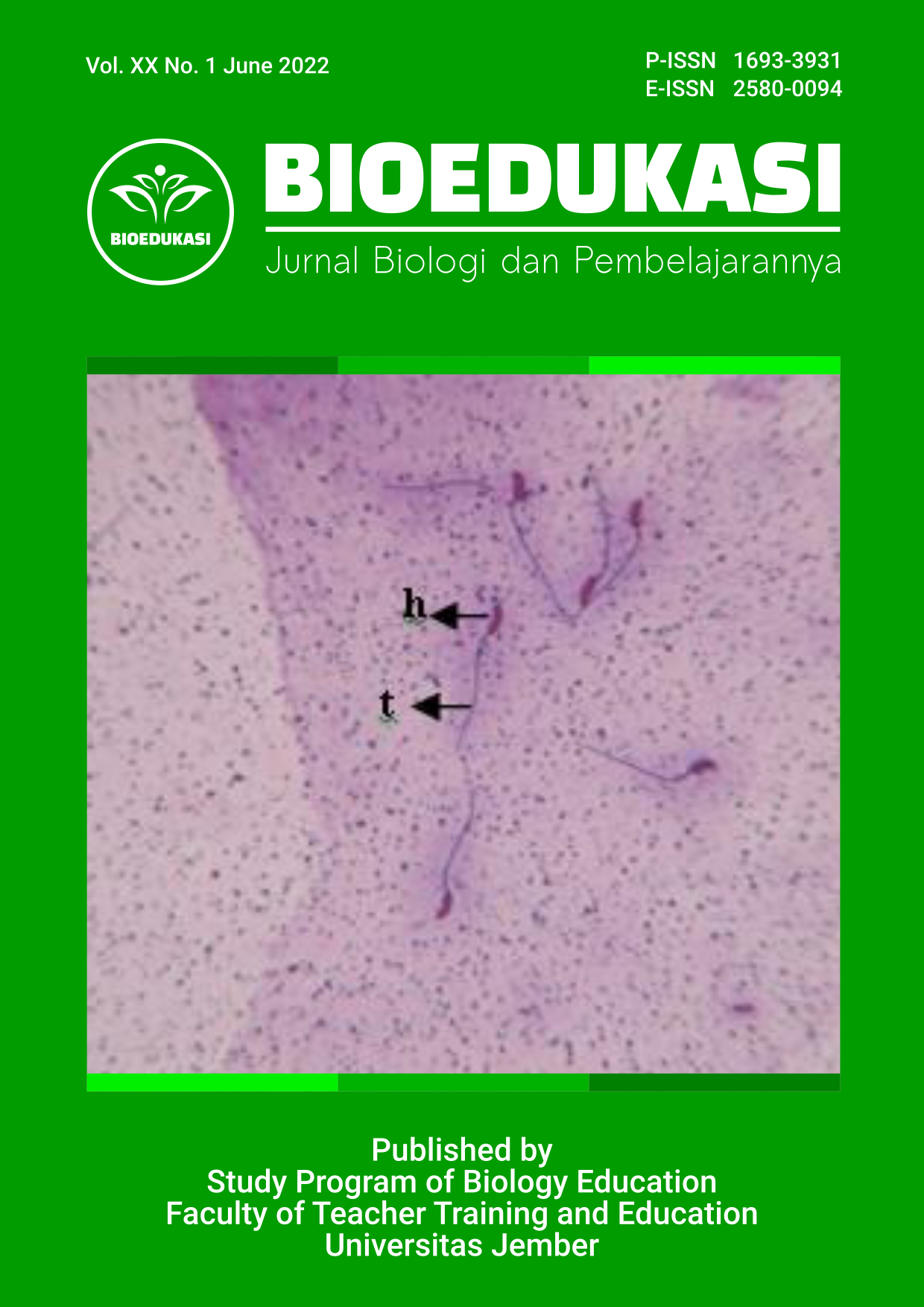EPIDERMAL CHARACTERISTICS AND EPIDERMAL DERIVATIVES OF THE LEAVES OF Ipomoea pes-caprae (L.) R. Br. IN THE DEPOK BEACH AREA OF YOGYAKARTA
Abstract
Depok Beach is a sandy beach that has limited vegetation because of strong winds, poor microclimate, and low availability of nutrients. One of the plants that can adapt to these extreme conditions is Ipomoea pes-caprae (L.) R. Br. One form of its adaptation to extreme environments is thickening the leaves. Other forms of adaptation can also be studied through the characteristics of the epidermis and the epidermal derivatives of the leaves, as the focus of this study. This type of research is exploratory research, including sampling, plant identification, leaf preparation using the leaf clearing method, and observing microscopic preparations. The data analysis used is descriptive quantitative. The data obtained include the characteristics of the epidermis and its derivatives in the form of stomata and trichomes. The results showed the average number of epidermal cells in the adaxial part of the leaves higher, that is equal to 54.05 ± 2.31 / 0.06 mm2. Stomata are parasitic and amphistomatic. The size of the stomata and the width of the stomatal pore on the adaxial surface of the leaf is smaller but has a higher average density, which is 5.80 ± 1.15 / 0.06 mm2. The trichomes found were of the glandular type.
References
Crang, R., Lyons-Sobaski, S., & Wise, R. (2018). Plant Anatomy: A Concept-Based Approach to the Structure of Seed Plants. Springer NAture Switzerland AG. https://doi.org/10.1007/978-3-319-77315-5
Djazuli, M. (2010). Pengaruh Cekaman Kekeringan terhadap Pertumbuhan dan Beberapa Karakter Morfo-Fisiologis Tanaman Nilam. Buletin Penelitian Tanaman Rempah Dan Obat, 21(1), 8–17. https://doi.org/10.21082/bullittro.v21n1.2010.%p
Dolatabadian, A., Modarres Sanavy, S. A. M., & Ghanati, F. (2011). Effect of Salinity on Growth, Xylem Structure and Anatomical Characteristics of Soybean. Notulae Scientia Biologicae, 3(1), 41–45. https://doi.org/10.15835/nsb315627
Fu, Q. S., Yang, R. C., Wang, H. S., Zhao, B., Zhou, C. L., Ren, S. X., & Guo, Y. D. (2013). Leaf Morphological and Ultrastructural Performance of Eggplant (Solanum melongena L.) in Response to Water Stress. Photosynthetica, 51(1), 109–114. https://doi.org/10.1007/s11099-013-0005-6
Hazzoumi, Z., Moustakime, Y., & Joutei, K. A. (2020). Essential Oils: Oils of Nature (H. El-Shemy (ed.); pp. 83–96).
Ilahi, R. nanda K., Isda, M. novaliza, & Rosmaina. (2018). Morfologi Permukaan Daun Tanaman Terung (Solanum melongena L.) sebagai Respon Terhadap Cekaman Kekeringan. Journal of Biology, 11(1), 41–48. http://dx.doi.org/10.15408/kauniyah.v11i1.
Kuster, V. C., da Silva, L. C., Meira, R. M. S. A., & Azevedo, A. A. (2016). Glandular Trichomes and Laticifers in Leaves of Ipomoea pes-caprae and I. imperati (Convolvulaceae) from Coastal Restinga Formation: Structure and Histochemistry. Revista Brasileira de Botanica, 39(4), 1117–1125. https://doi.org/10.1007/s40415-016-0308-5
Ma’ruf, A. (2016). Respon Beberapa Kultivar Tanaman Pangan terhadap Salinitas. Jurnal Penelitian Pertanian BERNAS, 12(3), 11–19. https://doi.org/10.7910/DVN/9LWHOU
Nadliroh, K., S. Widodo, C., & R. Santoso, D. (2015). Analisis Pengaruh Frekuensi Bunyi terhadap System Buka Tutup Stomata Tanaman Padi Varietas Logawa. Natural-B, 3(2), 187–192. https://doi.org/10.21776/ub.natural-b.2015.003.02.13
Nicolla, A. C., Irsyad, A. N., Firdasia, W., Sarifah, Z., Nilamsari, E. I., Umah, N., Daradwinta, R., & Sukirno, S. (2021). Comparison of Damselfly (Odonata: Zygoptera) Diversity in Wet Dune Slack Habitat with Canopied and Non-Canopied Areas of Gumuk Pasir Parangkusumo, Yogyakarta, Indonesia. IOP Conference Series: Earth and Environmental Science, 736(1), 2–10. https://doi.org/10.1088/1755-1315/736/1/012046
Nilam, R., Jyoti, P., & Sumitra, C. (2018). Pharmacognostic and Phytochemical studies of Ipomoea pes-caprae, an Halophyte from Gujarat. Journal of Pharmacognosy and Phytochemistry, 7(1), 11–18.
Noraini, T., Amirul-Aiman, A. J., Ruzi, A. R., Bunawan, H., & Nurdiana, S. F. (2021). Adaptation and Taxonomic Value of Leaf Anatomical Characteristics of Selected Ipomoea L. Species. Journal of Environmental Biology, 42, 872–878. https://doi.org/http://doi.org/10.22438/jeb/42/3(SI)/JEB-20
Prasetyawati, C. A., & Mangopang, A. D. (2013). Konservasi Kawasan Pesisir dengan Tanaman Nyamplung. Info Teknis EBONI, 10(1), 14–25. https://doi.org/10.20886/buleboni.5001
Prihastanti, E. (2010). Perubahan Struktur Pembuluh Xilem Akar Kakao (Theobroma cacao L.) dan Gliricidia sepium pada Cekaman Kekeringan. Bioma: Berkala Ilmiah Biologi, 12(1), 24–28. https://doi.org/10.14710/bioma.12.1.24-28
Purwaningrahayu, R. D., & Taufiq, A. (2017). Respon Morfologi Empat Genotip Kedelai terhadap Cekaman Salinitas. Jurnal Biologi Indonesia, 13(2), 175–188. https://doi.org/https://doi.org/10.47349/jbi/13022017/175
Puspitasari, D. A., & Salamah, Z. (2021). Analisis Hasil Penelitian Biologi sebagai Sumber Belajar Materi Jaringan pada Tumbuhan. Bioeduca: Journal of Biology Education, 3(2), 99–111. https://doi.org/10.21580/bioeduca.v3i2.7414
Setiawati, T., & Syamsi, I. F. (2019). Karakteristik Stomata Berdasarkan Estimasi Waktu dan Perbedaan Intensitas Cahaya pada Daun Hibiscus tiliaceus Linn. di Pangandaran, Jawa Barat. Jurnal Pro-Life, 6(2), 148–159. https://doi.org/10.33541/jpvol6Iss2pp102
Suarez, N. (2011). Comparative Leaf Anatomy and Pressure-Volume Analysis in Plants of Ipomoea pes-caprae Experimenting Saline and/or Drought Stress. International Journal of Botany, 7(1), 53–62. https://doi.org/10.3923/ijb.2011.53.62
Wardhani, F. K., & Poedjirahajoe, E. (2020). Potensi Pemanfaatan Ipomoea pes-caprae (L.) R. Br. di Hutan Pantai Petanahan Kebumen. Jurnal Ilmu Kehutanan, 14(2), 145–153. https://doi.org/http://dx.doi.org/10.22146/jik.61398
Zheng, J. X., Zhang, H., Su, H. X., Xia, K. F., Jian, S. G., & Zhang, M. (2018). Ipomoea pes-caprae IpASR Improves Salinity and Drought Tolerance in Transgenic Escherichia coli and Arabidopsis. International Journal of Molecular Sciences, 19(8). https://doi.org/10.3390/ijms19082252

This work is licensed under a Creative Commons Attribution-NonCommercial-NoDerivatives 4.0 International License.









 https://orcid.org/0000-0003-1920-0515
https://orcid.org/0000-0003-1920-0515
